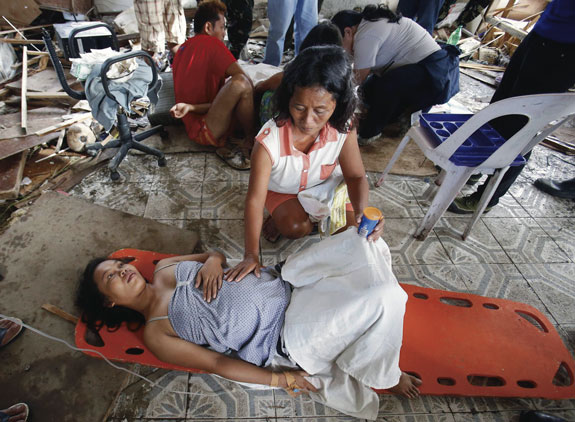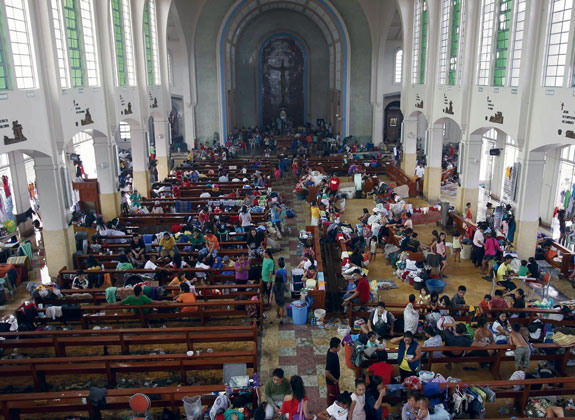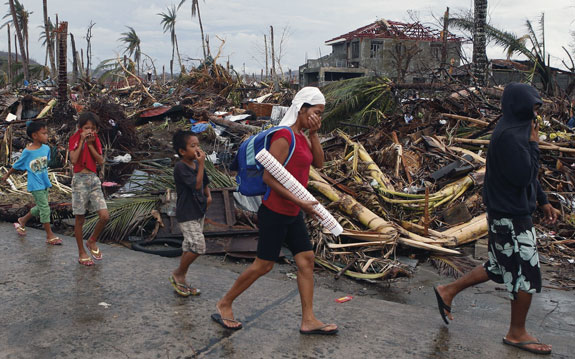
MANILA, Philippines (CNS) – International and local groups were poised to get aid to the worst-hit areas of the typhoon-stricken central Philippines, but the challenges of getting help to communities growing desperate for food and water went beyond just making sure roads were clear.
For the Jesuits who wanted to help, security was the priority.
Jesuit Brother James Lee, head of the Church That Serves the Nation, the social justice arm of the Philippine Jesuit province, said before anyone could take food and other supplies to the worst-hit areas, his organization would send someone to make sure there was a secure way that goods get to the right destination.
“Because even the military cannot pass and go to different areas,” Brother Lee told Catholic News Service. “They still have difficulty with communications as well as managing the people there, because they’re (Filipinos) really looking for food, and they’re asking the trucks (for food) and limiting their access.”
Brother Lee said he had heard from other nongovernmental agencies that partner with SLB, as his organization is known in the Philippines, that hungry people were demanding food in return for letting the trucks pass.
About 600,000 people have been made homeless by Super Typhoon Haiyan. In one of the worst-hit cities, Tacloban, a day after the storm hit, officials said the displaced started to loot grocery stores and shopping malls, picking them clean of food, water, medicine and even goods that were not basic necessities.

To try to restore order, the government sent hundreds of police and military backup and also imposed a curfew. But on Nov. 12, the Armed Forces of the Philippines said communist rebels ambushed its trucks on their way to Tacloban. The military said two rebels were killed in the incident.
Brother Lee explained that managing the potential danger of making a delivery would entail a step-by-step process. He said it was crucial that his organization first make contact with either another nongovernmental agency or the local parish to work out the logistics of moving the goods.
He said supplies would have to be taken in via military or humanitarian truck, and as they were being transported, an SLB representative in Manila should keep in constant contact with the local parish that would be receiving them.
Other Catholic aid agencies also sent in people to do initial assessments. The U.S. bishops’ Catholic Relief Services (CRS) sent an initial assessment team to Leyte island Nov. 10, and the first wave of staffers were scheduled to arrive Nov. 11 and 12. However, CRS staffers said a tropical depression was bringing more rain to the area hit by the typhoon.
With the Philippines being met with several disasters this year, including an earthquake in October and Typhoon Usagi, another Category 5 storm, in September, Manila Cardinal Luis Antonio Tagle put out a prayer for calamities Nov. 12.
The 10-line prayer asks for peace to those who have died, help for those who need it and that people be spared from natural disasters and devastations. It included:
“…Bless all those who extend their helping hand to those in need of food, shelter and clothing, who share their resources with others.
“At your command the wind and the seas obey, raise your hand, almighty God, and spare us from other natural disasters and devastations ….”
The U.S. bishops, meeting in Baltimore, passed a resolution asking all dicoeses in the U.S. to take a special second collection to assist the Philippines. The money would be donated to CRS officials, who have committed $20 million in emergency aid for survivors of Super Typhoon Haiyan.
“Our goal is to serve 100K families, about a half million people,” CRS President Carolyn Woo told the U.S. Bishops.
The bishops’ international relief and development agency was assembling assessment teams Nov. 11 to head into the disaster zone. Woo said the teams must be completely self-sufficient, because little remains in the worst-hit communities.
“They must be able to live in the field without any support,” she explained.
Bishop Gerald F. Kicanas of Tucson, Ariz., chairman of the CRS board, said the collection could be taken in dioceses the weekends of Nov. 16-17 or Nov. 30-Dec. 1.
In addition to the collection in parishes, donations are being taken online at http://crs.org. Donations also can be sent to CRS, P.O. Box 17090, Baltimore, Md., 21297-0303 or via phone by calling 877-435-7277.
CRS teams were hoping to gather 18,000 tarps for shelters, hygiene kits, water and sanitation supplies. The agency also planned to institute cash for work programs to provide income for people as they undertake debris removal, Woo said.
Bishop Kicanas noted that it is expected that some of the funds will be set aside for the reconstruction of Catholic churches, schools and agencies.

